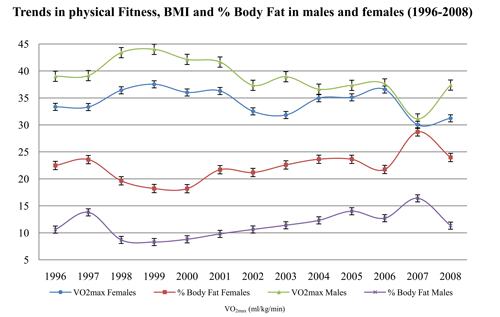Trends in Body Fat, Body Mass Index and Physical Fitness Among Male and Female College Students
Abstract
:1. Introduction
2. Materials and Methods
2.1. Participants
2.2. MicroFit testing
2.3. Body composition
2.4. Blood pressure and resting heart rate
2.5. Muscle strength
2.6. Flexibility
2.7. VO2max—the maximum uptake of oxygen during a graded exercise
2.8. Statistical analysis
3. Results and Discussion
3.1. Demographics
| Males | Females | |
|---|---|---|
| BMI: body mass index; BP: blood pressure; SD: standard deviation. | ||
| Gender (%, n) | 44.5 (2273) | 55.4 (2828) |
| Age (years; mean ± SD) | 21.5 ± 4.6 | 21.9 ± 5.8 |
| % Body Fat (mean ± SD) | 11.6 ± 6.5 | 22.4 ± 6.7 |
| Bicep Strength (kg; mean ± SD) | 41.7 ± 12.0 | 23.8 ± 7.4 |
| Flexibility (cm; mean ± SD) | 37.8 ± 12.1 | 43.1 ± 11.6 |
| Systolic BP (mmHg; mean ± SD) | 129.4 ± 15.3 | 118.4 ± 14.1 |
| Diastolic BP (mmHg; mean ± SD) | 76.7 ± 10.2 | 73.5 ± 9.4 |
| Resting Heart Rate (bpm; mean ± SD) | 73.1 ± 13.5 | 78.7 ± 12.9 |
| VO2max (mL/kg/min; mean ± SD) | 38.7 ± 11.0 | 34.2 ± 10.2 |
| Height (cm; mean ± SD) | 175.0 ± 7.5 | 162.2 ± 7.0 |
| Weight (kg; mean ± SD) | 77.1 ± 15.8 | 65.6 ± 16.0 |
| BMI (kg/m2; mean ± SD) | 24.1 ± 4.5 | 24.0 ± 5.3 |
3.2. Trends in fitness levels
3.3. Trends in BMI
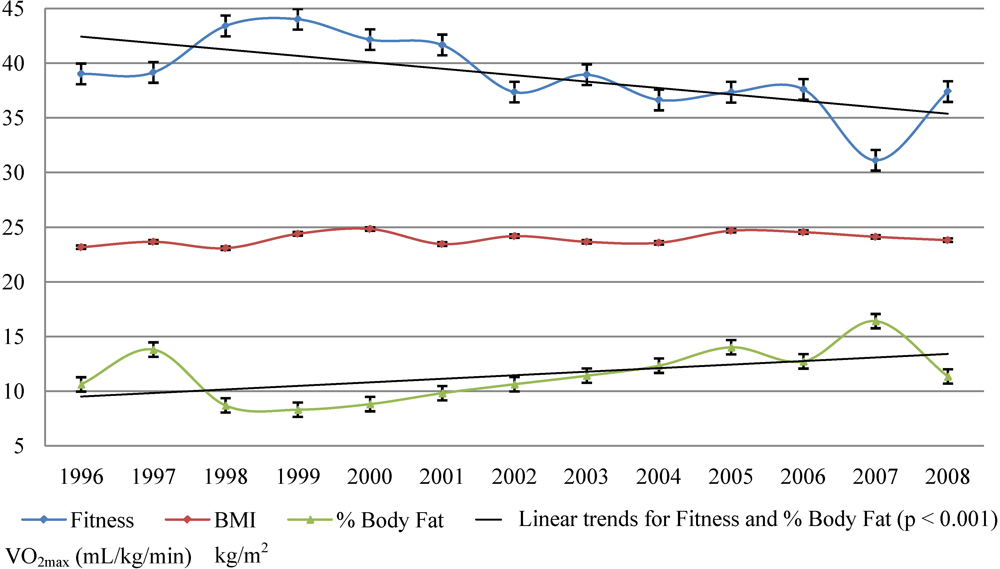
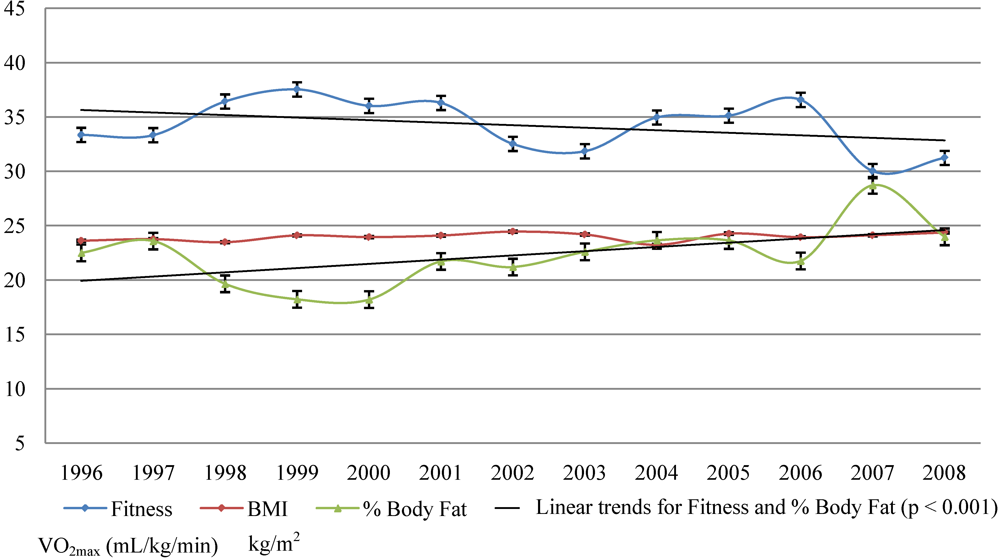
3.4. Trends in % body fat
3.5. Fitness categories
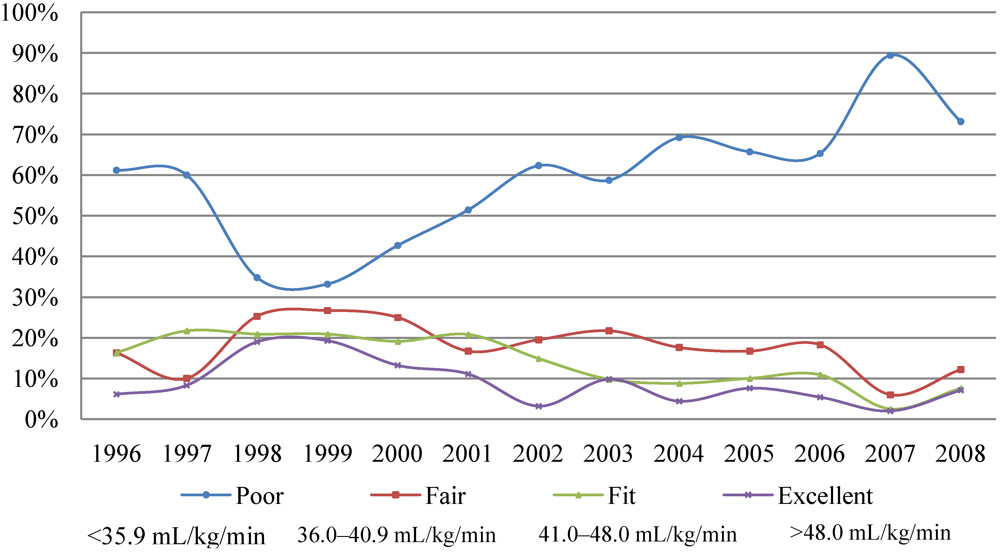
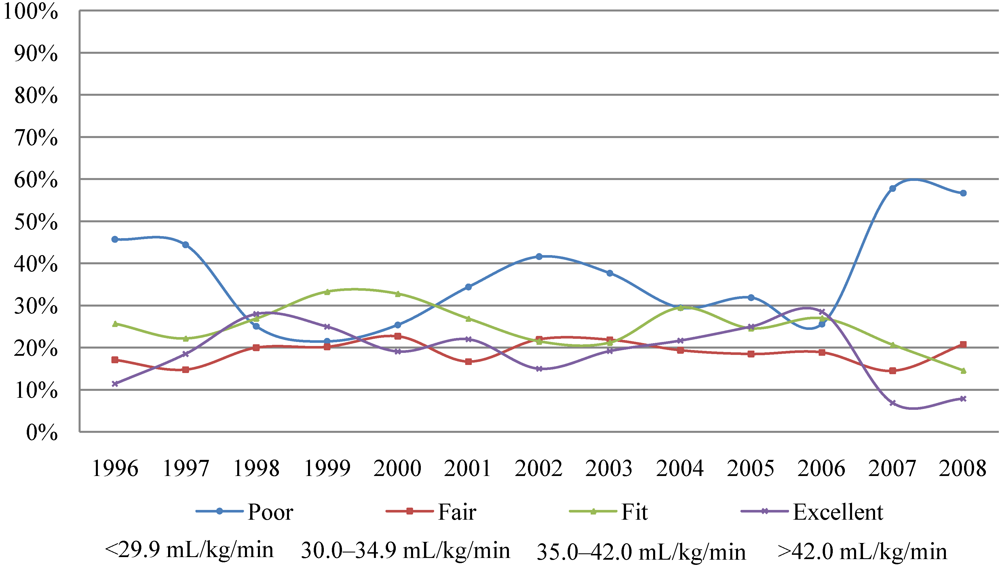
3.6. Limitations
4. Conclusions
Acknowledgements
References
- American College Health Association. American College Health Association-National College Health Assessment (ACHA-NCHA) Spring 2005 Reference Group Data Report (Abridged). J. Am. Coll. Health 2006, 55, 5–16.
- American College Health Association. National College Health Assessment Reference Group Executive Summary Fall 2008. Available online: http://www.acha-ncha.org/docs/ACHA-NCHA_Reference_Group_ExecutiveSummary_Fall2008.pdf (accessed on 12 June 2010).
- Sacheck, J.M.; Kuder, J.F.; Economos, C.D. Physical fitness, adiposity, and metabolic risk factors in young college students. Med. Sci. Sports Exerc. 2010, 42, 1039–1044. [Google Scholar]
- Powell, K.E. Habitual exercise and public health: An epidemiological view. In Exercise Adherence: Its Impact on Public Health; Dishman, R.K., Ed.; Human Kinetics: Champaign, IL, USA, 1988; pp. 15–40. [Google Scholar]
- Shaw, K.; Gennat, H.; O’Rourke, P.; Del Mar, C. Exercise for overweight or obesity. Cochrane Database Syst. Rev. 2006, 4, CD003817. [Google Scholar]
- Coyle, Y.M. Lifestyle, genes, and cancer. Methods Mol. Biol. 2009, 472, 25–56. [Google Scholar] [CrossRef] [PubMed]
- Brown, J.D. Staying fit and staying well: physical fitness as moderator of life stress. J. Pers. Soc. Psychol. 1991, 60, 555–561. [Google Scholar]
- Pertruzello, S.J.; Landers, D.M.; Hatfield, B.D.; Kubitz, K.A.; Salazar, W. A meta-analysis on the anxiety-reducing effects of acute and chronic exercise. Outcomes and mechanism. Sports Med. 1991, 11, 143–182. [Google Scholar] [PubMed]
- Crews, D.J.; Landers, D.M. A meta-analytic review of aerobic fitness and reactivity to psychological stressors. Med. Sci. Sports Exerc. 1987, 19, S114–S120. [Google Scholar]
- Etnier, J.L.; Salazar, W.; Landers, D.M.; Petruzzelo, S.J.; Myungwoo, H.; Nowell, P. The influence of physical fitness and exercise upon cognitive functioning: a meta-analysis. J. Sport Exerc. Psychol. 1997, 19, 249–277. [Google Scholar]
- Douglas, K.A.; Collin, J.L.; Warren, C.; Kann, L.; Gold, R.; Clayton, S.; Ross, J.G.; Kolbe, L.J. Results from the 1995 national health risk behaviour survey. J. Am. Coll. Health 1997, 46, 55–66. [Google Scholar]
- Bray, S.R.; Born, H.A. Transition to university and vigorous physical activity: implications for health and psychological well-being during transition to university life. J. Am. Coll. Health 2004, 52, 181–188. [Google Scholar]
- Lowry, R.; Galuska, D.A.; Fluton, J.E.; Wechsler, H.; Kann, L.; Collins, J.L. Physical activity, food, choice, and weight management goals and practices among US college students. Am. J. Prev. Med. 2008, 18, 18–27. [Google Scholar]
- Center for Disease Control. The Behavioral Risk Factor Surveillance System (BRFSS). Available online: http://www.cdc.gov/brfss/index.htm (accessed on 1 May 2010).
- Beeson, L.W.; Mills, P.K.; Phillips, R.L.; Andress, M.; Fraser, G.E. Chronic disease among Seventh-day Adventists, a low risk group. Cancer 1989, 64, 570–581. [Google Scholar]
- Fraser, G.E.; Shavlik, D.J. Ten Years of life—Is it a matter of choice? Arch. Intern. Med. 2001, 61, 1645–1652. [Google Scholar]
- White, E.G. The Ministry of Healing; Pacific Press Publishing Association: Mountain View, CA, USA, 1905. [Google Scholar]
- MicroFit Health and Fitness Systems. Colleges & Universities. Available online: http://www.microfit.com/site_colleges/index.html (accessed on 1 May 2010).
- Jackson, A.S.; Pollock, M.L. Generalized equations for prediction body density of men. Br. J. Nutr. 1978, 40, 497–504. [Google Scholar]
- Jackson, A.S.; Pollock, M.L.; Ward, A. Generalized equations for predicting body density of women. Med. Sci. Sports Exerc. 1980, 12, 175–182. [Google Scholar]
- Åstrand, P.-O.; Ryhming, I. A nomogram for calculation of aerobic capacity (physical fitness) from pulse rate during submaximal work. J. Appl. Physiol. 1954, 7, 218–221. [Google Scholar] [PubMed]
- Wang, J.; Thornton, J.C.; Kolesnik, S.; Pierson, R.N., Jr. Anthropometry in body composition. An overview. Ann. N. Y. Acad. Sci. 2000, 904, 317–326. [Google Scholar] [PubMed]
- Powers, S.K.; Howley, E.T. Exercise Physiology: Theory and Application to Fitness and Performance; McGraw Hill: Boston, MA, USA, 2009. [Google Scholar]
- McArdle, W.D.; Katch, F.I.; Katch, V.L. Exercise Physiology: Energy, Nutrition, and Human Performance; Lea & Febiger: Philadelphia, PA, USA, 1991. [Google Scholar]
- Wilmore, J.H.; Costill, D.L. Physiology of Sport and Exercise; Human Kinetics: Champaign, IL, USA, 2004. [Google Scholar]
- Mestek, M.L.; Paisance, E.; Grandjean, P. The relationship between pedometer-determined and self-reported physical activity and body composition variables in college-aged men and women. J. Am. Coll. Health 2008, 57, 39–44. [Google Scholar]
- McArthur, L.H.; Raedeke, T.D. Race and sex in college students physical activity correlates. Am. J. Health Behav. 2009, 33, 80–90. [Google Scholar]
- Taliaferro, L.A.; Rienzo, B.A.; Pigg, R.M.; Miller, M.D.; Dodd, V.J. Association between physical activity and reduced rates of hopelessness, depression, and suicidal behavior among college students. J. Am. Coll. Health 2008, 57, 427–435. [Google Scholar]
- USDA/HHS, Nutrition and Your Health: Dietary Guidelines for Americans, 5th ed; US Department of Agriculture and Health and Human Services: Washington, DC, USA, 2000.
- USDA/HHS, 2008 Physical Activity Guidelines for Americans; US Department of Agriculture and Health and Human Services: Washington, DC, USA, 2008.
- Grace, T.W. Health problems of college students. J. Am. Coll. Health 1997, 45, 243–250. [Google Scholar]
- Nicklas, T.A.; Baranowski, T.; Cullen, K.W.; Bergerson, G. Eating patterns, dietary quality and obesity. J. Am. Coll. Health 2001, 20, 599–608. [Google Scholar]
- Center for Disease Control and Prevention; National Center for Chronic Disease Prevention and Health Promotion, Physical Activity and Health: A Report of the Surgeon General; US Department of Health and Human Services: Washington, DC, USA, 1996.
- Hertzler, A.A.; Webb, R.; Frary, R. Overconsumption of fat by college students, the fast food connection. Ecol. Food Nutr. 1995, 34, 49–57. [Google Scholar]
- Grubbs, L.; Carter, J. The relationship of perceived benefits and barriers to reported exercise behaviours in college undergraduates. Fam. Community Health 2002, 25, 76–84. [Google Scholar]
- Pinto, B.M.; Marcus, B.H. A stage of change approach to understanding college students’ physical activity. J. Am. Coll. Health 1995, 44, 27–31. [Google Scholar]
© 2010 by the authors; licensee MDPI, Basel, Switzerland This article is an open-access article distributed under the terms and conditions of the Creative Commons Attribution license (http://creativecommons.org/licenses/by/3.0/).
Share and Cite
Pribis, P.; Burtnack, C.A.; McKenzie, S.O.; Thayer, J. Trends in Body Fat, Body Mass Index and Physical Fitness Among Male and Female College Students. Nutrients 2010, 2, 1075-1085. https://doi.org/10.3390/nu2101075
Pribis P, Burtnack CA, McKenzie SO, Thayer J. Trends in Body Fat, Body Mass Index and Physical Fitness Among Male and Female College Students. Nutrients. 2010; 2(10):1075-1085. https://doi.org/10.3390/nu2101075
Chicago/Turabian StylePribis, Peter, Carol A. Burtnack, Sonya O. McKenzie, and Jerome Thayer. 2010. "Trends in Body Fat, Body Mass Index and Physical Fitness Among Male and Female College Students" Nutrients 2, no. 10: 1075-1085. https://doi.org/10.3390/nu2101075



